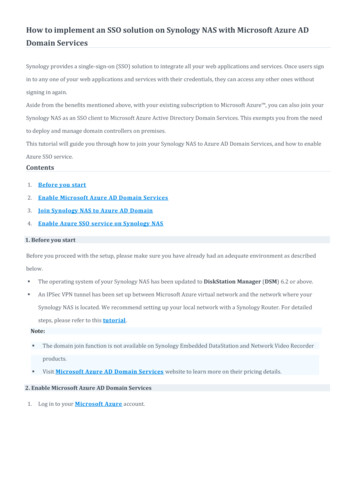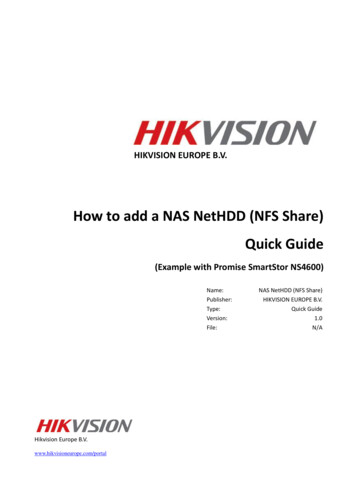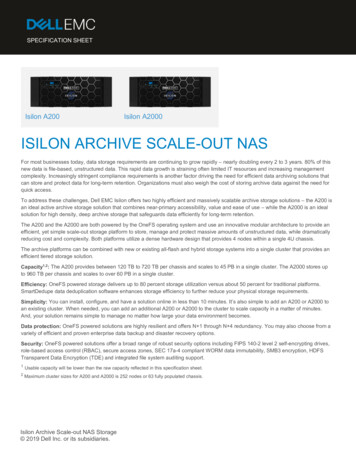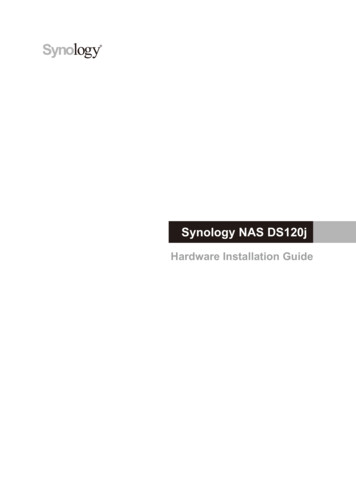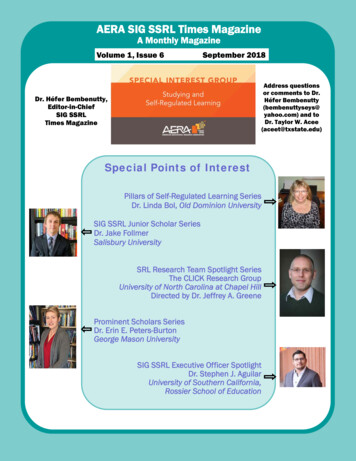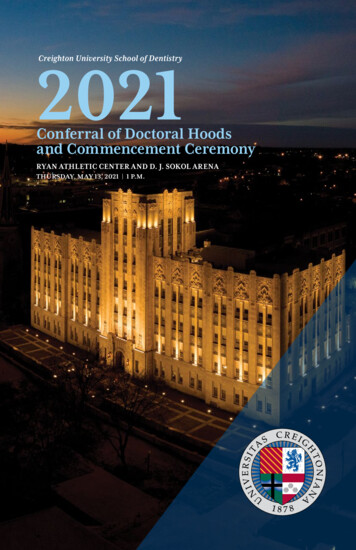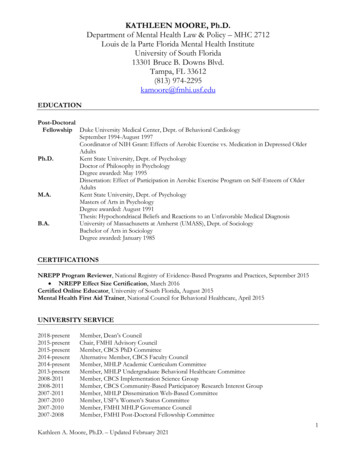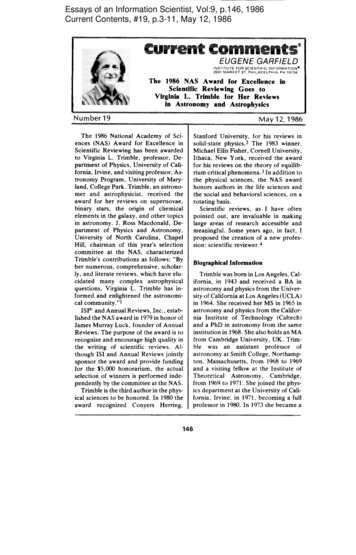
Transcription
Essays of an Information Scientist, Vol:9, p.146, 1986Current Contents, #19, p.3-11, May 12, 1986IEUGENE GARFIELDlNSTITUTEF08SCIENTIFICINFORMATION3501 MAR KETST,Ptil LA OELPHIA,PA 19104The1986 NAS Awardfor ExcellenceScientificReviewingGoestoVirginiaL. Trimblefor Her Reviewsin Astronomyand AstrophysicsNumber19inMav12,1986The 1986 National Academy of Sciences (NAS) Award for Excellence inScientific Reviewing has been awardedto Virginia L. Trimble, professor, Department of Physics, University of California, Irvine, and visiting professor, Astronomy Program, University of Maryland, College Park. Tnmble, an astronomer and astrophysicist,receivedtheaward for her reviews on supernovae,binary stars, the origin of chemicalelements in the galaxy, and other topicsin astronomy. J. Ross Macdonald,Departmentof Physics and Astronomy,University of North Carolina, ChapelHill, chairman of this year’s selectioncommitteeat the NAS, characterizedTrimble’s contributionsas follows: “Byher numerous, comprehensive,scholarly, and literate reviews, which have elucidatedmany complexastrophysicalquestions, Virginia L. Trimble has informed and enlightened the astronomical community. ”1Stanford University, for his reviews insolid-state physics. 2 The 1983 winner,Michael Ellis Fisher, Cornell University,Ithaca, New York, received the awardfor his reviews on the theory of equilibrium critical phenomena. s In addition tothe physical sciences, the NAS awardhonors authors in the life sciences andthe social and behavioral sciences, on arotating basis.Scientific reviews, as I have oftenpointed out, are invaluable in makinglarge areas of research accessible andmeaningful. Some years ago, in fact, Iproposed the creation of a new profession: scientific reviewer.4Biographkal InformationTrimble was born in Los Angeles, California, in 1943 and received a BA inastronomy and physics from the University of California at Los Angeles (UCLA)in 1964. She received her MS in 1965 inastronomy and physics from the California Institute of Technology(Caltech)and a PhD in astronomy from the sameinstitution in 1968. She also holds an MAfrom Cambridge University, UK. Trimble was an assistantprofessorofastronomy at Smith College, Northampton, Massachusetts,from 1968 to 1969and a visiting fellow at the Institute ofTheoreticalAstronomy,Cambridge,from 1969 to 1971. She joined the physics department at the University of California, Irvine, in 1971, becoming a fullprofessor in 1980. In 1973 she became aISI” and Annual Reviews, Inc., established the NAS award in 1979 in honor ofJames Murray Luck, founder of AnnualReviews. The purpose of the award is torecognize and encourage high quality inthe writing of scientific reviews. Although 1S1 and Annual Reviews jointlysponsor the award and provide fundingfor the 5,000 honorarium,the actualselection of winners is performed independently by the committee at the NAS.Trimble is the third author in the physical sciences to be honored. In 1980 theawardrecognizedConyersHerring,146
her modest assertions that her career hasbeen favoredheavily by luck andchance. Helmut A. Abt, Kitt Peak National Observatory,Tucson, Arizona,for example, characterizes Trimble as “avery remarkable person.” He points outthat her decision to study the CrabNebula at Caltech was certainly not anaccident,but a result of her extraordinary intellect and capabilities. “She isso intelligent,” he says, “and has such abroad backgroundin astrophysics andrelated sciences, that she can review afield much more capably than most people.”bOn Writfng ReviewsTrimble’s first published paper was anastronomical investigation of the GreatPyramid of Khuf u in Giza, Egypt.7 Hercareer as an author of astronomy reviews began at Cambridge. Her first efforts were reports on meetings held atthe university whale she was there as apostdoctoralfellow. She found thatonce she had written a few reviews, conference organizers and editors began toask for more.“I always learn an enormous amountfrom writing reviews,” she says, “’Whattypically happens in the process is that Isee a couple of interesting problems thatare ripe for solutions, and the next couple of research things I do are sort oftriggered by the review as I wrote it.After I did a review on binary stars, Ithought of a few binary star problems,and a similar thing happened after I did asupernova review.”sTable 1 provides a selected list ofTrimble’spublications,listed in descending order by number of citations.Two of the papers, “New gravitationalradiation experiments” and “A low-massprimary for Cygnus X-I?”, were coauthored by Trimble’s husband,JosephWeber, Department of Physics, Universit y of Maryland. Each review article ismarked by an asterisk. An extensivetwo-part paper in Revie WJ of ModernPhysics, for example, covers the historyVirginia L. Trimblevi. iting faculty member at the Universityof Maryland, where she is now a visitingprofessor in astronomy.As Trimble tells it, she entered astronomy virtually by chance. She was seeking admission to UCLA, and at that timethe application process involved selecting a field of study, UCLA had no undergraduate program in archeology, Trimble’s first choice, so she scanned theavailable subjects and selected astronomy. Chance, she says, seemed to guideher graduate studies as well. Her dissertation topic, essentially selected by theastronomy department at Caltech, dealtwith a gaseous mass known as the CrabNebula,a remnantof a supernova,which is an exploded star.In 1968, not long after Trimble completed her doctorate,a pulsating radiosource, called a pulsar, was discoveredin the Crab Nebula, creating great excitement in the astronomicalcommunity. “When pulsars came along,” saysTrimble,“and everybodywantedayoung postdoc to talk about the significance of the pulsar in the Crab Nebula,there I was just having finished a thesison the subject. ”sIt shouldbe notedthat few ofTrimble’s colleagues would agree with147
Table 1: A selected list of articles pubfished by V. Trimble listed in descending order by number of citations. An asterisk ( ) indicates that it is a review article. .4 citations from the SCP, 1955-1985. B bibliographic data.A163 “Trfmble V. The origin and abundancesBof the chemicalelements.Rev.Mod.Ph vs. 47:877-976,1975.13757Motions and structure of the filamentary envelope of the Crab Nebula. A tron. J.73:535-47, 1%8.Graenstefn J L & Trfmble V. The Einstein redshift in white dwarfs. Astrophys.J. 2.Trlmble1%9.TrfmbleTrfmble“TrfmbleV & GreenstefnJ L. The EinsteinV & Thorme K S. Spectroscopicredshiftbinariesin white dwarfs. IJf. A,trophys.and coffapsed stars, Astrophy .J.J.177:441-52,156:1013-9,V. On the distribution of binary system mass ratios. Asfron. J. 79:967-73, 1974.V & Rees M. The exoansion enerwf of the Crab Nebula. Astmoh w. Lett. 5:93-7. 1970.V & Refries F. The s lar neutrino”problem-aprogress(?) repo;t .’Re . Mod. Phys. 45:1-5,1973.20Weber J, Lee M, Gratz D J, Rydbeck G, Trfrnble V & Steppel S. New gravitational radiationexperiments, Phys. Rev. LeI/. 31:779-83,1973.Trlmble V. q(u) reconsidered,Observatory98:163-6,1978. . . . . . . . . . . . . . . . Binary stars in globular and open clusters. (Hesser J E, ed. ) Star chisrers. ProceedingsA tronornica/Union Sympo iumNo. 85, 27-30 August 1979, Victoria, B. C,,of the InternatiomdCanada. Dordrecht, The Netherlands: Reidel, 19LW.p. 259-79.Davfdson K, GrrU T R, Marm S P, Stecher T P, Fesen R A, Parke R A, Harvel C A, Kafatos M& Trfmbk V. The ultraviolet spectrum of the Crab Nebula. Astrophys.J, 253:6%-706,1982.“Trfmble V. Supernovae. Part I: the events. Rev. Mod. Phys. 54:1183-224,1982.Trimble V. Ionization and excitation in the Crab Nebula, Astron. J. 75:926-32, 1970,Trfmble V, Rose W K & Weber J, A low-mass primary for Cygnus X-I? Mon. Nofic. Roy. Astmn. oc. 162:1-3, 1973.TrfnrbJe V. Dynamics of the Crab Nebula. (Davies R D & Smith F G, eds. ) The Cmb Nebula.proceedingsof the [internationalA.[ronomicalUnion SymposiumNo. 46, 5-7 August 1970,Jodrell Bank, England, Dordrecht, The Netherlands: Reidel, 1971. p. 12-21.Trfmble V & Woltjer L. On the mass of the Crab Nebula. A trophys.J. 163: L97-8,1971.J L & Trfmbfe V. The gravitational redshift of 40 Eridani B. As(rophys,J. 175:LI -5,Greenstefn1612“Trfmble V. Supernovae. Part II: the aftermath. Rev. Mod, Phys 55:511-63,1983. . . . . . . . . . . . . . . . Optical observations of the Crab Nebula. (Davies R D & Smith F G, eds.) The Cmb3125242222222221211972.Nebula.Proceedingsof the t 1970, Jodrell Bank, England. Dordrecht, The Netherlands: Reidel, 1971. p. 3-11.10 “--------------- A field guide to the binary stars. Nature 203:137-42, 1983.8 Trfmble V & BeU R A. Spectroscopicdeterminationof stellar maases: Mene, Mene, Tekel,Arcturus. Quarf. J. Roy. AsIron. Sot. 22:361-79, 1981.5-7and likely futureof supernovaresearch. s.g The first part deals with themechanismsof supernovaexplosions,including the presupemova evolution ofstars and the observed propertiesofsupernova events.s The second part discusses the aftermathof supernovaevents, including such by-productsasgamma rays, X rays, nucleosynthesis,and supernova-inducedstar formation.gAnother review, appearing in Naturein 1983, discusses binary stars, which aresystems in which two or more luminousbodies orbit a common center of gravity. 10More than half the stars in our galaxy are binary systems. Trimble has alsoreportedon astronomymeetings andsymposia, such as the first EuropeanConferenceon Astronomy held at theUniversity of Leicester, UK, in 1975.11In addition to writing reviews and conducting her own research in astrophysics, Trimble has studied patterns andtrends in astronomicalliterature.Shereported in Nature on two studies doneby Abt. 12 In one study Abt charted thepublication histories of a cohort of 115astronomers who received their doctorates between 1945 and 1960. He alsostudied the citation histories of 22 outstandingastronomers. 13.14 Resultsshowed that the active members of the148
1945-1960 cohort had publicationrecords that increased monotonicallywithtime. Data from the Science Citation Zndex” (SCZ@) on the 22 astronomers,comparedwith biographicalinformation, demonstratedthat several of themwere well past middle age when theywrote their most-cited works. In general, the studies showed that astronomersdo not seem to fit the stereotype of thescientist who is most productive early inacareer.lzAbt, incidentally, wasoneofthe authors featured in our 1984 study ofastronomy journals.lsIn another study, Trimble examinedthe lengths of papers published in a selection of English-languagejournals inastronomy,chemistry,physics,andmathematics.She concludedthat theaverage length of scienttilc papers hasincreasedby 64 percent since WorldWar II. Trimble presents various interpretationsfor thw increase. One viewholds that longer papers in these disciplines reflect greater scientific content.Other interpretationspoint to changingeditorial practices and other sociologicalfactors that reward long articles. For example, methods of evaluating scientistsfor promotion and tenure have tended toattach high value to longer papers in recent years. Trimble, who tends to favorthis sociological view, concludes by suggesting that authors, editors, referees,and sponsoringagencies reach somekind of agreement to limit the drasticgrowth in the length of papers and letters. lb However true this may be forastronomy, it does not appear to be truein other fields, where one hears regularcomplaintsabout the use of the leastpublishable unit.Trimble also used the SCI to analyzecitations to papers by a sample of authors from the American AstronomicalSociety (AAS). The study concentratedon number of citations as a function ofcareer length,subdiscipline,gender,and institutionof employment.Shefound, among other things, that X-rayand radio astronomersare cited lessoften than optical astronomers.She alsodetermined that the average number ofcitations per person was proportional tocareer length. 17In another recent study, to appear inthe Czechosio vak Journa! of Physics,Trimble set out to determine what fraction of citations in astronomy area resultof personal influence-citations,for example, that authors give to the work ofcolleagues and friends. She comparedcitations to two groups: a sample of recently deceased astronomers and a control group of those still living and active.Trimble determined that approximately40 percent of citations can be traced topersonal influence. la Incidentally,theexecutive editor of the Czechoslo va kJournal of Physics is Jan V1ach , a citation analyst extra ordinaire.Research-Front DataAccording to our data, Trimble is theauthor (or coauthor) of approximately180 publications.Through1985, herwork has received about 950 citations.One lengthy review on “The origin andabundancesof the chemical elements”appeared in Reviews of Modern Physics. 19 ThN 1975 review summarizes efforts to determinethe distributionofchemical and isotopic abundances in thegalaxy, to identify relevant nuclear processes and their sites, and to formulate amodel of the evolution of galaxies thatwould account for these processes andthe observed abundances.One of theauthors cited by Trimble is Harold C.Urey, the 1934 Nobel laureate in chemistry. Trimble mentions an important 1956compilationof cosmic abundances,ofwhich Urey was a coauthor. I discussed thk paper in my tribute to Ureyand his work. zlTnmble’s review has been cited about160 times. Figure 1 presents a chronological dwtributionof 1975-1985 SC1citations to this paper. It was co-citedfrequently enough in 1981 to be included149
FJgure 1: Chronologicaldistributionof 1975-1985SCP citations to V. Trimble’s 1975 paper in Rev.Mod.Phys.1YEARSin the core of a 1981 ISI Cl researchfront on “Isotopic anomalies in meteorites in relation to solar-system formation” (#81-1062). A Cl-level researchfront consists of current papers that citeany of a group of high-impact books orarticles that were frequently cited together (co-cited). Table 2 lists the corepapers for thk research front.Figure 2 is a historiograph,a string ofannual researchfrents,showing research on the formation of the solar system. As I’ve explained previously, weare able to detect the linkages betweenresearch fronts from year to year byidentifying the core documents that continue to be co-cited. zz As research in aparticularfield diversifies,the frontsthemselves split, merge, or disappear,and new fronts appear.The h toriographin Figure 2 showsthe link between front #81- 1062 andmore recent research fronts, such as aand other1984 front on “Photometrystudies of nuclear fission and evolutionof stars, globular clusters, and other celestial bodies” (#84-0837). To demonstrate the relationshipbetween frontH84-0837 and other subspecialty areas inastrophysics, we have included the multidimensional-scalingmap in Figure 3.By clustering research fronts we cancreate these higher level maps, in thiscase representing a second level, or C2,research front, “Determinationof elemental abundances and other aspects ofstars, nebulae, and galaxies” (#84-0075).Of all the fronts representedhere,#84-0837 is the largest, with 60 coredocuments and 557 citing documents.Why Wrfte Reviews?Trimble believes that review articlesare particularlyvaluable in education.“A student who’s getting geared up to doa thesis needs to find out quickly wherehis thesis work fits into the great schemeof things. The same applies to someoneTable 2: A fist of core documents for C l-level research front / 81-1062, “Isotopicrelation to solar-system formation .“anomaliesin meteoritesBurMdge E M, Burbidge G R, Fowler W A & Hoyle F. Synthesis of the elements in stars. Re},. Mod.29:547-650,inPhys1957.Cameron A G W. Abundances of the elements in the solar system. Spare Sci. Rev. 15:121-46, 1973.Cfayton D D. Principlesof stellar evolutionand rrucleosynthesis.New York:McGraw-Hill,1963, 612 p.Clayton RN, Grossman L & Mayeda T K. A component of primitive nuclear composition in carbonaceousmeteorites. Science182:485-8,1973.Clayton R N, Onuma N & Mayeda T K. A classification of meteorites based on oxygen isotopes.Earth P/anet Sci. Lett. Xl lC-8, 1976.L & Larfmer J W. Early chemical history of the solar system. Rev, Geophys.SpacePhysGrossman12:71-101, 1974.Lee T, Paptsnastmsiou D A & Wasserfmrg G J. A1uminum-26 in tbe early solar system: fossil or fuel?Astrophys.J. 211 :L107-10,1977.R S, Srinivasm B & Anders E. Host phase of a strange xenon component in Allerrde. Science190:1251-62, 1975.Trfmbie V. Tbe origin and abundances of the chemical elements. Re . Mod. Phys. 47:877-976,1975.Lewis150
Figure 2: Historiograph of research on the formation of the solar system. The numbers given in parentheses following the research-front titles refer to the numbers of core/citingitems for each research front. An asterisk ( ) next to the research-front number indicates the research front for which Trimble’s 1975 paper in Rev. Mod. Phys. is part of the core.76-016377-0198Trx#Comrnsiliin cdnmimriras:chnmical 1IISW%ohments inprlmitiwmotwt.s(2/36)04 mm solarsystem -012976-0772Cowosllbn0! AB411deMotMfi19 (4/56)79-0153Nohb gJS,SMlandmetwilemolns(3/39)79-0820IaompicmOm#nDs scdnpkl-kmhnaaasinanmraN4sin nwtwrhtand Stmrw lutbll(2/32).ImotWn4s andsdar-s stemfemwtbn;B2-1339P.00gmwixin motwrirosand chondrbs(2/31)(9/140)83-1789Mhwalwand p4tr040gy01 Ch4ndrilo and 9)n73-0379Nuclearrotallon(9/79}75-1504 00c0upkdband:(2/32)76-167381-0919P81ikkcwpting andNudoafincmpmssibiliiy mddwupling(3/40)Iluwl(2/37)82-2643mows ofnuck*rdm%kvdi@ribuOOns(2/31)El84-S650Mod#Is ofmagiz nuckl(?/21 )
3: Multidimensional-scalingmap of C2-level research front #84-C075, “Determinationof elementalabundances and other aspects of stars, nebulae, and galaxies.” showing links between Cl-level researchfronts on the map. An asterisk (‘) indicaies the C 1-level research front found on (he h toriographin Figure 1. A 1964 research-frontnumber. B research-frontname. The numbers of core/citing items aregiven in 1256\ studies of gravitational waves, radial \elocity, and other properties of binarystars, black holes, and other binary bodies (3/39)84-0304 Pre-equilibriumemission of protons and neutrons in heavy-ion reactions (7/71)84-0385 Infrared, ultraviolet, magnetic, and other spectroscopy of binary stars ( 19/210)84-0606 Observations of infrared radiation from Wolf-Rayet binaries and evolution process, and massloss in supergiant and massive stars (20/263)“84-0837 Photometry and other studies of nuclear fission and evolution of stars, globular clusters, andother celestial bodies (60/557)84-0979 Structure and evolution of galaxies and the universe based on observations of radio jets,quasars, and other radio sources (31/458)8.-1231Observations of optical, radio, and infrared emission from M82 and other spiral galaxies(8/197)84-1’444 Magnetic, optical, and radio observations of sunspot umbrae (3/18)84-1446 Light nucleon emission and momentum transfer during uranium-238 and gold- 197 fission (5/51 I84-1490 Theory and observation of the solar magnetic fieId and stellar dynamos (9/95)8’-1510Fusion-fission cross sections and fission fragment angular distributions in uranium-238 andother heavy-ion collisions ( 15/156)84-1668 Observations of radio emissions associated with galactic nuclei from Seyfert galaxies (5/88)Doppler patterns84-2220 Variations in solar rotation, sunspot cycles, and analysis of photospheric(9/50)84-2836 Observations and calculations of C-4, carbon monoxide, c yanoradical, formaldehyde,andother species in interstellar clouds (3/53)84-2940 Mass exchange in dissipative heavy-ion collisionsand theoretical approaches to hea}y-ionreaction mechanisms (4/50)84-3053 IUE and ultraviolet observations of stars and galaxies (4/ 114)84-34)58 Ultraviolet, optical, and infrared observations of interstellar elements in diffuse clouds, stars,and galaxies(3/70)84-3S@3 Spectrophotometryand radio emis. ioris from planetary nebulae, stars, and galaxies (4/ 135)A84-0134{continued152on ne’.rt Daee)
4-9256M-942784-9446X-ray observations and radio emissions from galaxies, quasarx, and supernova remnants(s/ 144)Optical observations of R136, NGC-3603, and other massive objects (2/22)Mass loss and emission in stars and stellar clusters (2/39)Gravitationalcollapse and relaxation dynamics in globular clusters (3/30)Broad abwmption lines in spectra of quasi-stellar objects, and observations of quasars andgalaxies (5/53)High-resolutionobservation of radio emission in W51 and other radio anurces (2/ 17)Observation and evolution of supernova remnants (7/77)Spectroscopicdeterminationof chemical abundances in the sun, other stars, planetarynebulae, and interstellar environments(8/191)X-ray, ultraviolet, radio, and other observations of quasars, galaxies, quasi-stellar objects, andother emission sources (2/49)X-ray, optical, and other observations of supernova remnants and other stara in largeMagellanic Clouds (7/75)Evolution and photomet of globular clusters and galaxies (6/85)Primordial nucleosynthesisand the evolution of stats in the big bang (3/81)Near-infrared and infrared photometryof stars and galaxies (2/41)X-ray and other studies of coronal structure, magnetic activity, and chromosphericemission inmain sequence, solar, and bkmry stars (15/ 182)Generator coordinate and other methods in nuclear scattering and collective mndels (2/48)Photometry and studies of the evolutionof stars and clusters in the Magellanic Clouds (8/90)Spectrophotometricdeterminationof temperatureand other properties of white dwarfs andother stars (2/41 )Distribution of molecules and molecular fragments in the circumstellar envelope ofIRC 10216, M1ra. and other stars (3/42)Observationof chromosphericactivity in flare stara (2/15)Photomehyof Wolf-Rayet and early-type binary stars (2/24)Elemental abundance analysis of stars, measurement,and calculation of oscillator strengthsand atomic spectroscopy (2/ 16)Polarization and emission variations in a-orionis (2/2.0)Digital angiography, optical detectors for spectroscopy,and determinationof chemicalabundance in stars (3/25)Observations and structure of the solar chromosphere(2/48)writing reviews”: dealing with editorsand their ubiquitous blue pencils. Shenotes that in some instanceseditorsseem to apply dtiferent standards to review articles and want to make changesin style and content that they wouldn’tordinarily make in other papers.“I think that this may be the largestobstacle to writing reviews, ” she says.“The people who are really capable ofdoing it, the ones who are working actively in a subject, just can’t be botheredwith the editorial squabbles. They maydo one review article and then decide itjust isn’t worth the bother.” She adds,with a laugh, “One effect I’ve noticedsince winning this award is that editorshave become unexpectedlymore respectful of my wishes. I hope it lasts. ”sI take special pleasure in writing aboutand paying tribute to a starry-eyed citation analyst. It was also a pleasure tostarting a post-doctoral project in a newsubject or somebody teaching a newsubject for the first time. The actual audience that reads reviews is larger thanthat, but that’s where I think reviews areparticularly needed. And those are thepeople I try to keep in mind when I writethem.”sIn her teaching as well as in preparingher reviews, Trimble places a great dealof emphasis on good, clear writing.“WhenI’vetaughtundergraduatecourses I’ve tended to ask the students towritea lot of essays,” she says, “even ifthe course was something fairly technical. I feel that in addition to being able tosolve various problems, students shouldbe able to teU others what they’veIearned.”sTrimble’s extremecare about herwriting, in fact, has often led to what shecalls “the single most difficult part of153
speak with Dr, Trimble recently and discuss a range of topics. She noted, for example, that the proportion of female astronomers in the US has remained ataround 10 percent since the AAS wasfounded in the 1890s. This proportion isevident in the very first group photograph of AAS members, in fact, as wellas when one examines the 4,000-oddnames in the current AAS directory.Trimble also says she is continuing hercitation stud es and recently completeda study on the self-citationrate inastronomy. 23Next year’s NAS award will be presented for reviews in the social and behavior-al sciences. Nominations should be submitted before September1986, to theOffice of the Home Secretary, NationalAcademy of Sciences, 2101 ConstitutionAvenue, Washington, DC 20418.*****My thanks to Chn.rtopher King andAmy Stone for their help in the preparation of this essay.019S61S1REFERENCES1. Macdonald J R. Letter to Bryce Crawford, Jr. 7 November1985.Gmfield E. The 1980 NAS James Murray Luck Award for Excellence in Scientific Reviewing:Conyers Herring receives second award for his work in solid-state physics.JOm,us of an informationscientist.Philadelphia: 1S1 Press, 1981. Vol. 4. p. 512-4.(Reprinted from: Currerrf CorIIent (25):3-5, 23 June 1980. )3. --------------- The 1983 f4AS Award for Excellence in Scientific Reviewing goes to MichaelEllis Fisher for his reviews of the theory of equilibrium critical phenomena. Ibid., 1984. Vol. 6.p, 139-43, (Reprinted from: Currenf Confenf ( 18):3-7, 2 May 1983.)4. --------------- Propuaal for a new profession: scientific reviewer,Ibid.,1980. Vol. 3. p. 84-7,5. TrJmble V. Personal communication,3 March 1986.6. Abt H A. Personal communication.1 April 1986.7. Trfmble V. Astronomicalinvestigationconcerningthe se-calledair shafts of Cheeps’ Pyramid.Mift. Inst. Oriemforsch.10:183-206,1964.8. --------------- Supernovae. Part I: the events, Re,. Mod. Phys. 54:1183-224,1982,Supernovae, Part 11: the aftermath. Rev. Mod. Phy. S5:51 1-63, 1983.9. --------------10. --------------- A field guide to the binary starx. Nature 303:137-42, 1983.11. --------------- The first European Conference on Astronomy.Quarf. J. Roy. Asiron. SO. 17:25-42, 1976.12. --------------- The best is yet to be. Nature 303:382, 1983,13. Abt H A. Statistical publication histories of American merican astronomers publish their most-citedpapera? Publ. Astron. Sot. Pac. 95:113-6,1983.journals-whatthey cite and what cites them.15. Garffeld E. Journal citation studies. 43. AstrosciencesOp. cit., 1985. Vol. 7. p. 1S2-63. (Reprintedfrom: Current Contenr (21):3-14, 21 May 1984. )16. Trfmble V. Postwar growth in the length of astronomical and other scientific papers.Pub/. AsfrorI.foc, Pac. 96: l@37-f6, 1984.17. --------------- Some notes on patterns in citations of papers by American astronomers.Quart. J. Roy. Astmn.26:40- 3, 1985.14.---------------At what ages did outstanding18. --------------- Death comes as the end: the effects of ceaaation of personal influence upon rates ofcitation of astronomical papers. Czech. J. Phys. (In press. )19. --------------- The origin and abundances of the chemical elements.Rev. Mod. Pfrys. 47:877-976, 1975.20. Sueas H & Uray H C. Abundances of the elements. Rev. Mod, Phy . 28:5374, 1956,21. Garffeld E. A tribute to Harold Urey. Op. cit., 1981, Vol. 4. p. 333-7.22. --------------- Computer-aidedhi.storiography-how1S1 uses cluster tracking to monitorthe “vital signs” of science. (3P. cit., 1983. Vol. 5. p, 473-83.23. Trfmble V. Personal communication.2 April 1986.154
ISI” and Annual Reviews, Inc., estab-lished the NAS award in 1979 in honor of James Murray Luck, founder of Annual Reviews. The purpose of the award is to recognize and encourage high quality in the writing of scientific reviews. Al-though 1S1 and Annual Reviews jointly sponsor the award

